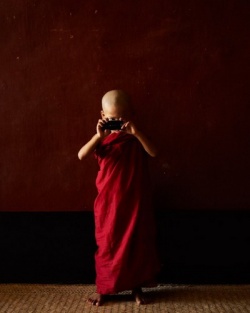Difference between revisions of "Ari Buddhism"
| Line 1: | Line 1: | ||
[[File:Boy-monk14.jpg|thumb|250px|]] | [[File:Boy-monk14.jpg|thumb|250px|]] | ||
| − | Ari Buddhism (Burmese: အရည်းဂိုဏ်း, IPA: [əjí ɡáiɴ]) is the name given to the religious practice common in Burma, prior to {{Wiki|Anawrahta}}'s rise and the subsequent conversion of Bagan (Pagan) to [[Theravada]] Buddhism in the eleventh century. It was introduced in the 7th century, possibly through trade contact from India or Tibet. It has largely been categorized as a [[Vajrayana|Tantric]] form of [[Buddhism]], combining elements of both Buddhism, nat worship, indigenous [[naga]] worship and Hinduism. Some scholars claim that it is related to the Buddhist religious practices of the Kingdom of Nanzhao and the subsequent Kingdom of Dali in modern-day Yunnan, China. Other historians like Than Tun contend that the Aris were forest-dwelling monks who simply differed in monastic practice from [[Theravadin]] [[monk]]s, especially with regard to adherence to the [[Vinaya]], the Buddhist monastic code, as they were much less orthodox, allowed to consume alcohol, engage in sexual relations and eat midday. | + | [[Ari]] [[Buddhism]] ([[Burmese]]: အရည်းဂိုဏ်း, IPA: [əjí ɡáiɴ]) is the [[name]] given to the [[religious]] practice common in [[Burma]], prior to {{Wiki|Anawrahta}}'s rise and the subsequent [[conversion]] of [[Bagan]] ({{Wiki|Pagan}}) to [[Theravada]] [[Buddhism]] in the eleventh century. It was introduced in the 7th century, possibly through trade [[contact]] from [[India]] or [[Tibet]]. It has largely been categorized as a [[Vajrayana|Tantric]] [[form]] of [[Buddhism]], combining [[elements]] of both [[Buddhism]], nat {{Wiki|worship}}, indigenous [[naga]] {{Wiki|worship}} and [[Hinduism]]. Some [[scholars]] claim that it is related to the [[Buddhist]] [[religious]] practices of the {{Wiki|Kingdom}} of [[Nanzhao]] and the subsequent {{Wiki|Kingdom}} of {{Wiki|Dali}} in modern-day {{Wiki|Yunnan}}, [[China]]. Other {{Wiki|historians}} like Than Tun contend that the Aris were forest-dwelling [[monks]] who simply differed in [[monastic]] practice from [[Theravadin]] [[monk]]s, especially with regard to adherence to the [[Vinaya]], the [[Buddhist monastic code]], as they were much less {{Wiki|orthodox}}, allowed to consume [[alcohol]], engage in {{Wiki|sexual}} relations and eat midday. |
{{W}} | {{W}} | ||
[[Category:Buddhist Terms]] | [[Category:Buddhist Terms]] | ||
[[Category:Vajrayana]] | [[Category:Vajrayana]] | ||
[[Category:Mahayana]] | [[Category:Mahayana]] | ||
Latest revision as of 04:57, 1 January 2014
Ari Buddhism (Burmese: အရည်းဂိုဏ်း, IPA: [əjí ɡáiɴ]) is the name given to the religious practice common in Burma, prior to Anawrahta's rise and the subsequent conversion of Bagan (Pagan) to Theravada Buddhism in the eleventh century. It was introduced in the 7th century, possibly through trade contact from India or Tibet. It has largely been categorized as a Tantric form of Buddhism, combining elements of both Buddhism, nat worship, indigenous naga worship and Hinduism. Some scholars claim that it is related to the Buddhist religious practices of the Kingdom of Nanzhao and the subsequent Kingdom of Dali in modern-day Yunnan, China. Other historians like Than Tun contend that the Aris were forest-dwelling monks who simply differed in monastic practice from Theravadin monks, especially with regard to adherence to the Vinaya, the Buddhist monastic code, as they were much less orthodox, allowed to consume alcohol, engage in sexual relations and eat midday.
